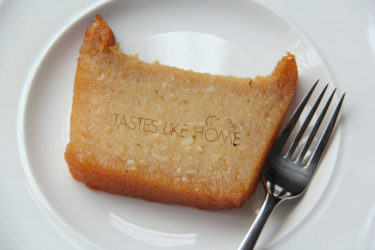Hi Everyone,
As you know by now, I am not really a dessert person, however, I really like certain baked items when made properly. Salara, sweet (coconut) bread, and cassava pone are my favourites. Last month when I realized that I could make cassava pone without having to grate the cassava, I didn’t know if to laugh or cry. Actually I think I wanted to do both. This revelation meant that I could make cassava pone anytime I wanted (laughter). But now with such ease, I would be tempted to make and eat pone more often than would be good for my sugar intake (cry). You see my dilemma.

I never did ask Mar (who made the pone) if she used ready-grated cassava or if she had blended it. I’m sure she would have told me but I also know that sometimes people want to have their own little ‘kitchen secrets’.
Experimenting on your own is fun but it is always encouraging when you have others around with whom you can engage in a discussion about what you are doing; seeking their advice, reassurance and sometimes approval. I decided to do this no-grate cassava pone while mommy was visiting. Yeah, no pressure there at all (lol).

My plan was to peel the cassava, cut it into chunks and puree it in a blender (not food processor). The recipe called for water to be added to the pone mixture anyway so I was going to blend the cassava with the amount of water stipulated in the recipe (I was using the recipe from my book which mom had assisted me in creating).
I arrived home from the market early on a Saturday morning with the two main ingredients for the pone – cassava and coconut. I cracked and quickly grated the coconut. I peeled the cassava, and when I was done, I was filled with doubt and anxiety about pureeing the cassava instead of grating it. I kept asking mommy over and over if I should go ahead and blend it. I knew that my constant asking was because I wanted her to tell me to blend it. By this time I was chiding myself for not buying extra cassava to grate just in case this experiment did not work out.
I wasn’t afraid of failure; that’s what experimenting is all about. I just didn’t want to fail in front of my mother; I chided myself again, this time, for choosing to do this experiment while she was around. The issue wasn’t just that it was my mother, but someone who is an excellent cook and baker. Like I’ve said before – no pressure!
With the cassava all chopped up I put the first batch into the blender and added a little water. I pressed the puree button on the blender and used the pulse button to control the blending.
The cassava quickly broke down and a few times I used a spatula (when the blender was off) to mix the cassava and then pulse intermittently until the cassava was completely pureed. When the first batch came out perfectly smooth, I was overcome with relief and giddy with laughter. I quickly worked through the bowl of chopped cassava – pureeing/pulsing – until it was all done. The rest as they say, is history.
While the oven preheated, I measured and mixed together the cassava, coconut, sugar, butter, and spices. Once mixed, everything was transferred to a baking pan and then into the oven. It was a torturous afternoon – pone takes time to cook and a longer time to cool enough so that it can be easily removed from the pan and sliced.
As expected, I ate way too much pone that evening and the next day.
Mommy’s reaction to the pone? “This is really good pone.” She asked for seconds. That’s high praise from my mother.
So if you feel like eating cassava pone this weekend, don’t grate, puree in a blender.
Cynthia





